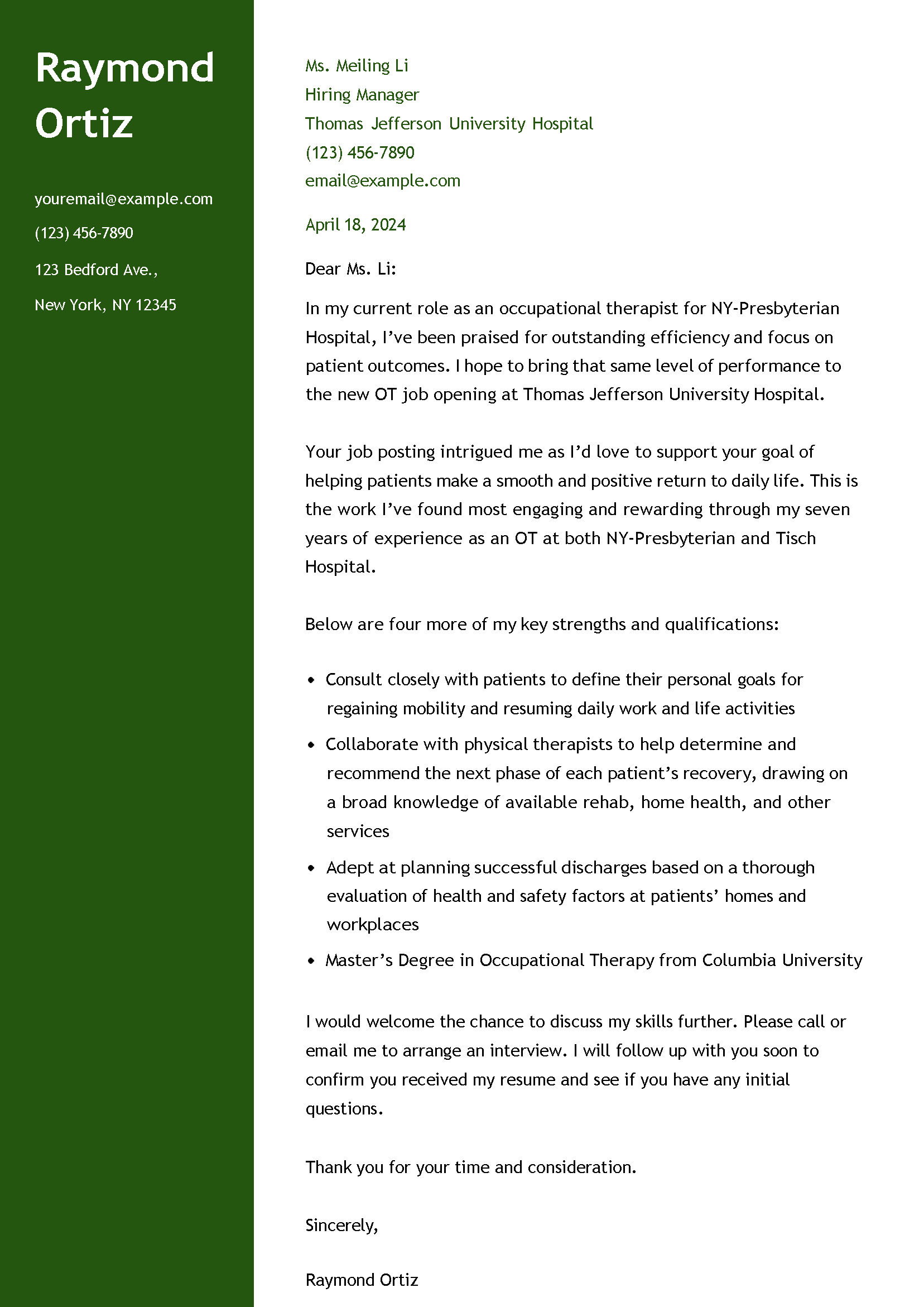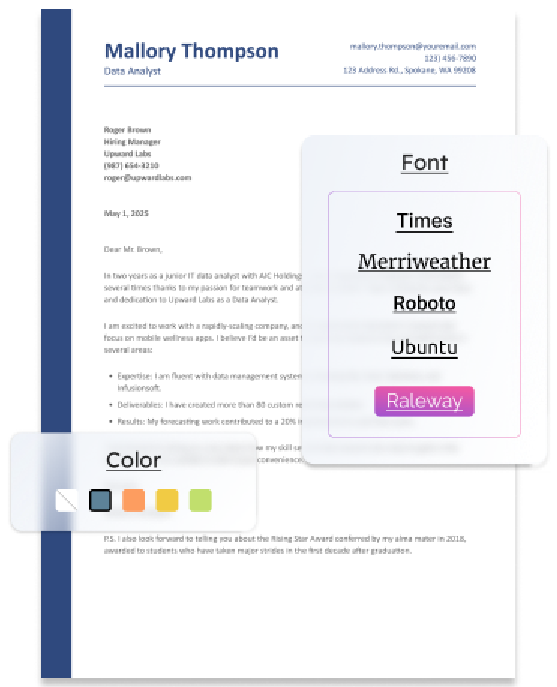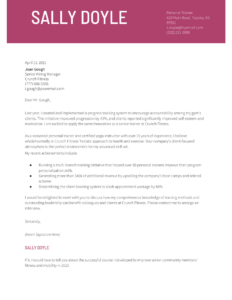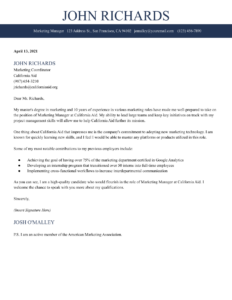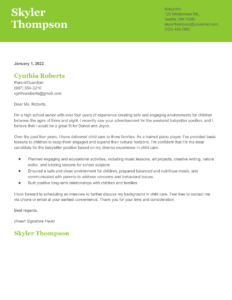To write a good occupational therapist (OT) cover letter, focus on your skill in helping people return to everyday life after an illness or injury. Express your interest in the health care organization, and show your related strengths like patient goal-setting, discharge planning, or finding solutions.
This guide will help you write a cover letter that gets you interviews for your next OT job.
Occupational Therapist Cover Letter Templates and Examples
- Entry-Level
- Mid-Career
- Senior-Level
How To Write an Occupational Therapist Cover Letter
A good OT cover letter usually has five sections, outlined below. When possible, connect each section to your defining health care skills and the organization’s hiring needs. The following advice and examples show what to include in your cover letter so it’s optimized for each job application.
1. Heading
At the top of the page, include:
- Your name and contact information
- The date
- The recipient’s name, title, health organization, and contact information (when available)
(Note: Feel free to omit this section if you send your letter by email and your contact details are part of your email signature.)
Example
Melissa Anderson
Occupational Therapist | 123 Carpenter St., Philadelphia, PA 12345 | (123) 456-7890 | [email protected]
April 18, 2024
Ms. Lori Taylor
Hiring Manager
Boston Medical Center
(123) 456-7890
[email protected]
2. Salutation
Whenever you can, address your recipient by name – it’s the quickest way to signal you’re sending a job-specific letter and not a boilerplate. If you can’t find the recipient’s name, use a variation of “Dear Hiring Manager” so your greeting is still tailored somewhat to each job opening.
Examples
Dear Ms. Li:
Dear ABC Hospital Hiring Manager:
3. “Hook” or introduction
To catch the reader’s attention, start your letter with a clear example of your success as an OT. Consider how you’ve improved health care services – maybe you found a new way to support OT assistants or introduced home-based solutions for people with disabilities. In the OT cover letter example below, see how the applicant quickly connects his chosen highlight to strengths he’d bring to the hiring hospital.
Example
In my current role as an OT at Massachusetts General Hospital, I helped develop training modules that improved the performance of newly hired OT assistants. I hope to bring that same sense of teamwork and innovation to your hospital’s advertised OT position.
4. Body paragraph(s)
On a separate document or sheet of paper, take 10 minutes to brainstorm why this OT role or employer interests you. For instance, maybe the hospital emphasizes continuous procedure improvement, a key focus of your most recent job.
When you’re done brainstorming, review your notes: Do any stand out as important or persuasive? Take another 10 minutes to brainstorm and elaborate on them. Repeat this process until you have two or three concise sentences that speak to the job opening. By adding these to your cover letter, you can show managers you’re responding to their job posting directly.
Following this explanation, cite a few more of your key achievements or qualifications, possibly as bullet points.
Example
I’m drawn to your description of a health care setting that values patients’ recovery of daily living skills after a major health event. This is my passion. Nothing motivates me more than helping patients set and achieve renewed activity and mobility goals.
My work highlights and qualifications also include the following:
- Provide case managers with insight and analysis that supports responsible discharge planning
- Offer ideas and suggestions to make patients’ home or work environment safer and more conducive to a healthy lifestyle
- Master’s degree in occupational therapy from Temple University
- Highly efficient, drawing on prior work experience in the service industry
5. Call to action
Finally, request an interview for the position. Consider restating your ability to help people return to daily life smoothly. To end your cover letter, use a simple closing like “Sincerely” or “Best regards” and then your name.
Example
I would welcome the chance to discuss my skills further. Please call or email me to arrange an interview. I will follow up with you soon to confirm you received my resume and see if you have any initial questions.
Thank you for your time and consideration.
Sincerely,
Raymond Ortiz
Occupational Therapist Cover Letter Tips
1. Highlight your varied health care skills
Add a short list of bullet points to show your success in key work areas for an OT, such as patient goal-setting or discharge planning. Given the collaborative nature of your role, highlight your work with physical therapists, case managers, or patients’ family members and employers.
Example
Additionally, I’d prove an asset to your organization based on my skills in these three areas:
- Collaboration: Provide detailed updates after each patient consult to ensure nurses’ full awareness of progress and any ongoing concerns
- Continuous improvement: Contribute ideas and strategies to streamline operations further, standardize policies, and advance team success
- Patient consultation: Help individuals set clear, attainable goals for regaining mobility and resuming daily work, life, and social activities
2. Mention your relevant traits
Desired qualities in OTs include compassion, collaboration, and adaptability. Consider which of these traits describe you best, then give an example or two of how you’ve shown them in a work setting.
3. Keep it concise
Limit your cover letter to one page, or around 250 words. Focus on work highlights, and resist the urge to tell your whole career story. Give just enough detail to pique hiring managers’ interest so they take a closer look at your resume.
Occupational Therapist Text-Only Cover Letter Templates and Examples
- Entry-Level
- Mid-Career
- Senior-Level
Raymond Ortiz
Occupational Therapist | 123 Bedford Ave., New York, NY 12345 | (123) 456-7890 | [email protected]
April 18, 2024
Ms. Meiling Li
Hiring Manager
Thomas Jefferson University Hospital
(123) 456-7890
[email protected]
Dear Ms. Li:
In my current role as an occupational therapist for NY-Presbyterian Hospital, I’ve been praised for outstanding efficiency and focus on patient outcomes. I hope to bring that same level of performance to the new OT job opening at Thomas Jefferson University Hospital.
Your job posting intrigued me as I’d love to support your goal of helping patients make a smooth and positive return to daily life. This is the work I’ve found most engaging and rewarding through my seven years of experience as an OT at both NY-Presbyterian and Tisch Hospital.
Below are four more of my key strengths and qualifications:
- Consult closely with patients to define their personal goals for regaining mobility and resuming daily work and life activities
- Collaborate with physical therapists to help determine and recommend the next phase of each patient’s recovery, drawing on a broad knowledge of available rehab, home health, and other services
- Adept at planning successful discharges based on a thorough evaluation of health and safety factors at patients’ homes and workplaces
- Master’s Degree in Occupational Therapy from Columbia University
I would welcome the chance to discuss my skills further. Please call or email me to arrange an interview. I will follow up with you soon to confirm you received my resume and see if you have any initial questions.
Thank you for your time and consideration.
Sincerely,
Raymond Ortiz
Occupational Therapist Cover Letter Frequently Asked Questions
What’s the difference between a resume and a cover letter?-
A resume may show you’re qualified for the job, but a cover letter shows you want it. More than repeating resume points, your cover letter should explain why the job caught your eye or the organization strikes you as a great fit, setting the stage for a positive interview. In this way, a good cover letter sharpens your application by letting you say directly what your resume can only indicate.
Should I say “My name is…” on a cover letter?-
No. As long as your name appears in the letter’s closing section, you don’t need to state it otherwise.
How should I format my cover letter?-
Like your resume. Carry over that document’s basic format settings, such as font style, line spacing, and page margins. When you style your cover letter like your resume, you make your application more cohesive and memorable.
Craft a new cover letter in minutes
Get the attention of hiring managers with a cover letter tailored to every job application.
